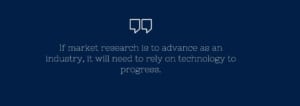How market research can be more profitable with the right software
I was going to call this blog article “Rethinking market research software expenditure”, but I thought it would be too easy to ignore. There is an ever-growing range of software available for various market research activities. Some of it is inexpensive; some comes with a hefty price tag at tens of thousands of dollars per year. With most market research software licences sold on an annual licence basis, it’s easy for a research agency to renew its licences without considering alternatives.
No change, no pain, no gain
Changing software brings pain, particularly to a busy research agency where the staff are all familiar with working within the confines of the existing software. As a software supplier, I would expect more clients to challenge me and ask if there are better ways of doing things and whether they are using the right software. It’s easier not to change. And, yes, change comes at a cost, but for how long in reality?
Technology can spur market research forwards
The 2020 Coronavirus crisis is going to damage most research agencies; some, for some it may, unfortunately, prove a fatal blow. At such times, there is a need for every company to reappraise the way it works and look to improve. Similarly, every industry needs to look at ways to improve. Technology is usually the key to this, and I believe technology holds the keys to moving market research forward.
I was going to call this blog article “Rethinking market research software expenditure”, but I thought it would be too easy to ignore. There is an ever-growing range of software available for various market research activities. Some of it is inexpensive; some comes with a hefty price tag at tens of thousands of dollars per year. With most market research software licences sold on an annual licence basis, it’s easy for a research agency to renew its licences without considering alternatives.
Want to listen to the podcast on this subject? Click here
Cut costs or rethink costs?
I attended a small local conference a year or so ago where the speaker – let’s call him George – told the audience that if a business can reduce its costs, it will be more profitable. In fairness, George offered some excellent tips such as checking your direct debits for unused software subscriptions. When I checked, he was right. His advice saved me a few pounds each month. However, he disliked my question at the end of his talk. I differed in opinion to George as I stated that increasing or decreasing costs could go either way. Decreasing costs could increase or decrease profitability, and increasing costs could increase or decrease profitability as well. I, perhaps, rudely suggested that his talk should be re-titled “Rethinking costs” rather than “Reducing costs”. He did not want to agree with me.
Rethinking software costs
I contend that many research agencies should be reappraising what they spend on software. I truly believe that reducing expenditure on some software and increasing spending on other types of software can lead to increased profitability. So, unlike George, I am going to look at where savings may be possible (but not always) and where spending on software can make an impact (but not always). Finally, I will look at some ways that “the market research model” might benefit from a rethink.
Let’s deal with the negatives first
Any change means pain. Staff often don’t like to change. Staff often don’t want to learn new systems. Change costs money. Training in new systems costs money. The list goes on. But, everyone has to remember why we run a business. Yes, it’s highly important to look after staff well – it’s the way to have a successful company as more enlightened companies have found. However, research agencies exist to deliver customers what they want.
If change means you can provide something better, more valuable or closer to expectations, this must be a good thing as long as you can achieve it at a realistic cost.
The change in market research: Rely on technology
If market research is to advance as an industry, it will need to rely on technology to progress. The genuine threat is that if market research doesn’t keep moving forward, a business sector on the periphery of the market research sector will steal the business. Some would argue that it is already happening. Let’s look at how.
Similar but different
I am drawn to a quotation by Bill Gates, who knows a thing or two about technology and software. “The advance of technology is based on making it fit in so that you don’t really even notice it, so it’s part of everyday life.” The question to ask yourself if you are willing to take part in a rethink is this: “What should be part of everyday life?” The market research industry’s core product is conducting surveys and delivering insights. That doesn’t need to change. What can make a similar product more effective and improve profitability?
 Online online online
Online online online
The move to online surveys for quantitative research has gradually grown. However, we work extensively in Asia where paper questionnaires represent 50% or more of research in some countries. While some purists still think face-to-face is the only right approach, the market research industry as it stands would barely exist in some countries if it wasn’t able to work online. Arguments about the difficulties of reaching specific audiences online are fading in almost every country as communications continue to improve around the world.
The move to online needs to happen
I recently interviewed Yanti Nisro in a podcast. Yanti is former President of PERPI, the Indonesian market research association and is currently ESOMAR representative for Indonesia. She was in no doubt that research in Indonesia had to move online. The current COVID-19 crisis had changed opinion amongst many researchers in Indonesia, it seemed. You can hear the podcast here. This doesn’t mean that all research has to be online, but online means lower costs, allowing more expenditure to be channelled into improving the rest of the ‘research product’. Besides, if you don’t move online, someone else will.
When you can buy cheaper
Choosing software takes time, as does trialling software. It’s easy to pick a solution and stick with it – simply because it’s easier. This can lead to costly mistakes. You can spend less and get a product that is just as good – George will like this! My best examples are in the area of online data collection where two particular common mistakes are seen time and again.
a. Low entry costs with high costs for high usage
Many of the online platforms start at low prices; some are even free for a small surveys. What you need to consider carefully is the cost of using the platform if your usage is likely to increase over time. Pricing plans vary considerably. Many software suppliers have ‘prices on application’ for any larger commercial volumes. Many platforms only offer a small reduction in the cost per interview if you hit normal levels for market research agencies. Let’s compare our Snap product against SurveyToGo. Snap has a lot of functionality for analysis and reporting tools over and above SurveyToGo and is priced at US$2000 for 2000 interviews within one year. For 100,000 interviews, the price is just US$6100. However, SurveyToGo is priced at US$550 for 2000 interviews, but US$21700 for 100,000 interviews (Prices as at 11/06/20). SurveyToGo is typical of many online data collection platforms. I chose SurveyToGo as a comparator, mainly due to its openness to its pricing, which should be applauded.
b. A cheaper product may be just as good
At the other end of the spectrum, there are some highly-priced products like Confirmit and Decipher. These are robust, complete products that can do ‘everything’. The question you need to ask yourselves, though, is whether you need ‘everything’ and do you want to have highly skilled staff that need to learn a scripting language? It is important to have tools that can make a survey engaging; otherwise, your response rates will drop, but you may just need two or three ways of displaying potentially uninteresting rating scales. Good online surveys, unless they need to be heavily branded and, perhaps, integrated within a website, only need clarity and be reasonably interesting to complete. Free tools can often do this as well as high priced products that may cost ten times as much per interview.
c. Use two products if it makes sense
Given that some products can cost ten times as much as other products, it is worth considering using two products for online surveys – one for those complex surveys that need programming (if you need that level) and one for the more regular work. If you can do 90% in the cheaper product, you may save US$000s per year on your online data collection costs.
Dashboards in preference to PowerPoint
I have long believed that market research data should be available in dashboards. PowerPoint presentations sometimes have their place, but they are static and inconvenient to browse. Market research has been slow to put data into online dashboards and for a perfectly sensible reason – cost. Not too long ago, online dashboards were custom-built by developers. They were expensive, slow to develop and only practical for major tracking studies. Tools like Tableau and Confirmit have come into the market, but they are still too expensive for most market research projects. Further, some of the tools are not ‘market research-friendly’ and cannot (easily) handle standard requirements like top two box analysis, multi-response questions and much more. We have launched The CYS Platform as a viable product for all research agencies for all projects.
Presenting other business data alongside research data
I believe that market research data is not valued enough at the highest levels in big organisations. I think one of the main reasons for this is that research data is often presented in isolation. Research data must be available alongside other business data that is relevant to research buyers – this may be sales, advertising expenditure, targets, other KPIs. This needs a technology solution that allows data streams to merged automatically so that research buyers can view research data as a complete picture. The best dashboards and other online reporting systems provide this solution, preferably in real-time.
Transferable data
When choosing software, the data you store in that product must be easily transferable to another system. You can never be sure of your clients’ ultimate needs, so flexibility is not just an advantage, it’s a necessity. The expectation is that transferring data to other platforms is easy. Without checking this, it will mean that you may not be able to transfer software products easily and, more importantly, you may not be able to meet client needs.
Remove bottlenecks
Every business has bottlenecks. It’s a question of how damaging those bottlenecks are. Considering what software can improve project flow, productivity and delivery capabilities should have a high priority. I have seen companies baulk at buying a tool that costs less than US$1000 when it would save hours and reduce errors. George might not approve, but, by now, I hope you feel that George was wrong!

Sell trackers but keep it simple
Software tools in market research are improving to automate tracking studies. Tracking studies have tended to the most profitable types of work for research agencies, but even this needs a rethink. Generally speaking, online surveys mean shorter surveys. There is an untapped market for smaller, low-cost tracking studies that can be, more or less, automated, delivering that data in helpful online dashboards. The Customer Experience Feedback market has grabbed this business from market research agencies, but there is plenty of scope for market research agencies to offer this as a competitively-priced service to attract more business. The software tools, especially ours, make this a new viable business.
Where does MRDC stand in these changes?
We have focused our software development on productivity for many years. Our current focus is on delivering a better product/service to research buyers. This is why we have linked all of our software tools to Snap for automated PowerPoint reporting and to The CYS Platform for automated online dashboards. Both products come with data collection modules and advanced data management modules that allow you to merge data from different sources. And, all at an affordable price. Maybe, it’s time to ignore George and speak to us by contacting sales@mrdcsoftware.com




 Online online online
Online online online





